
Submitted by Administrator on Mon, 08/05/2017 - 14:08
In an exciting new development in the war on plastic waste, Cambridge researchers have discovered a common insect larva that is able to break down chemical bonds in polyethylene plastic bags at higher rates than any method found previously. Scientists say the discovery could be a possible opportunity to help remove harmful polyethylene waste from the environment and landfills.
Synthetic Biology SRI members have collaborated on an exciting new paper published recently in Current Biology. Two members of the SynBio SRI; Paolo Bombelli and Prof. Christopher Howe (both of the Department of Biochemistry), collaborated with Federica Bertocchini (Spanish National Research Council (CSIC), and Universidad de Cantabria) on the paper. They found larvae of the waxworm Galleria mellonella have the ability to biodegrade polyethylene: a common component of plastic packaging and damaging environmental pollutant, currently taking between 100 and 400 years to degrade in landfill sites.
The work began in 2012 after a chance discovery by Federica Bertocchini, an amateur beekeeper, who noticed several Galleria mellonella wax worm larvae infesting her beehive. Typically considered a pest of beehives across Europe, she carefully removed the wax worms and placed them in a typical plastic bag before carrying on with her work. By the time she looked back, she noticed the bag was riddled with holes, and the larvae had escaped. They had completely eaten through the plastic.
Curious as to the mechanism behind this, she contacted Paolo Bombelli, and using spectroscopic analysis they found that rather than simply damaging the plastic bags through mechanical action, the caterpillars (or possibly the bacteria in their gut), were actually degrading the polyethylene through an oxidative mechanism, and on a timescale more rapid than any method seen previously. Furthermore, the reaction was producing ethylene glycol, a compound useful in making solutions such as antifreeze.
Through a series of timed experiments, the authors found that within 40 minutes of leaving 100 wax worms in a plastic bag, holes would appear, and if left longer, the bags would became completely shredded. After just 12 hours, there was a reduction of 92mg from the bag, representing an extremely fast rate of degradation compared to other reported methods, such as bacteria that biodegrade some plastics at a rate of just 0.13mg per day. The authors found a blended up homogenate of the waxworms also had the same effect on the plastic bags, with holes again typically appearing within around 40 minutes of being smeared on the polyethylene. The authors hypothesise the natural history of the wax worms might provide an answer to why they are able to generate such interesting characteristics: the beeswax on which the wax worms grow is composed of a highly diverse mixture of lipid compounds, including alkanes, alkenes, fatty acids and esters, not dissimilar to the chemical structure of polyethylene, suggesting this trait may be useful in burrowing into beehives.
The next step is to investigate the actual mechanism behind the degradation seen here and attempt to produce the enzymes on a larger scale, which is where synthetic biology tools may prove useful. "If a single enzyme is responsible for this chemical process, its reproduction on a large scale using biotechnological methods should be achievable," - stated Paolo Bombelli, first author of this study. If the DNA sequence coding for the enzyme could be taken and expressed in a standard bacterial vector, such as E. coli, this could allow for industrial production of enzymes that can break down polyethylene pollutants in the environment. It could also be possible improve the useful lifespan of the enzymes and generate more effective variants. Given the scale of plastic production, this finding could prove an incredibly exciting avenue in which synthetic biology tools could be used to reduce the environmental impact of plastic pollution. This work is complemented by the publication of other studies which found similar characteristics in the mealworm Tenebrio molitor, which has recently been shown can biodegrade polystyrene.
Paolo and the authors of the study were keen not to overstate the importance of the work however, as there is much that is still unknown. The exact mechanism by which the wax worms break down the plastic and the resulting carbon produced is still unclear, as is the mechanism behind which plastic degrading enzymes could be actually used by industry. “It is more complicated than simply sprinkling enzymes onto a landfill site” - stated Paolo Bombelli, first author of the study. “We need to know that the products of these reactions are also not going to have adverse environmental consequences before going ahead”. Despite these caveats, the study represents an exciting new possibility for the application of synthetic biology tools in alleviating environmental pollution.
If you would like to contact the authors of this study to find out more or get involved, email Paolo at pb346@cam.ac.uk. They are eager to work with members of the Cambridge synthetic biology community.

